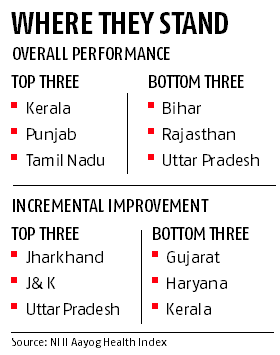Why in news?
NITI Aayog recently released a comprehensive Health Index report titled “Healthy States, Progressive India”.
What is the report on?
- It ranks all states and Union territories based on their year-on-year incremental change and overall performance in health.
- All States and UTs have been ranked in three categories to ensure comparison among similar entities.
- They are accordingly Larger States, Smaller States, and Union Territories (UTs).
- The report has been developed by NITI Aayog with technical assistance from the World Bank.
- Ministry of Health and Family Welfare (MoHFW) was also consulted in the process.
- The report is the first attempt to establish an annual systematic tool to measure and understand the nation’s health performance.
What are the highlights?
- Larger States - The Health Index is a weighted composite Index, which for the larger States, is based on indicators in three domains.
- These are Health Outcomes (70%), Governance and Information (12%) and Key Inputs and Processes (18%).

- Among the Larger States, Kerala, Punjab and Tamil Nadu ranked on top in terms of overall performance.
- Jharkhand, Jammu & Kashmir, and Uttar Pradesh ranked as top three States in terms of annual incremental performance.
- Some of the indicators for incremental performance ranking include:
- Neonatal Mortality Rate (NMR)
- Under-five Mortality Rate (U5MR)
- Full immunization coverage
- Institutional deliveries
- People Living with HIV (PLHIV) on Anti-Retroviral Therapy (ART)
- Uttar Pradesh, Rajasthan, Bihar, Odisha and Madhya Pradesh occupied the bottom ranks.
- Odisha is estimated to have the highest neonatal mortality rate at 35 per thousand live births.
- Smaller States - Among Smaller States, Mizoram ranked first followed by Manipur on overall performance.
- In terms of annual incremental performance Manipur ranked top followed by Goa.
- Manipur registered maximum incremental progress on indicators such as:
- PLHIV on ART
- First trimester antenatal care (ANC) registration
- Grading quality parameters of Community Health Centres (CHCs)
- Average occupancy of key State-level officers
- Good reporting on Integrated Disease Surveillance Programme (IDSP)
- UTs - Among UTs, Lakshadweep showed best overall performance as well as the highest annual incremental performance.
- It showed the highest improvement in indicators such as:
- institutional deliveries
- tuberculosis (TB) treatment success rate
- transfer of National Health Mission (NHM) funds from State Treasury to implementation agency
What does it imply?
- Trend - Clearly, States with a record of investment in literacy, nutrition and primary health care have achieved high scores.
- States and UTs that start at lower levels of development are generally at an advantage in notching up incremental progress.
- Whereas for States with high Health Index scores, it is a challenge to even maintain their performance levels.
- E.g. Kerala ranks on top in terms of overall performance but sees the least incremental change.
- However, the incremental measurement reveals that about one-third of States have registered a decline in their performance in 2016 as compared to 2015.
- Significance - Health-care delivery is the responsibility of States, with Centre providing the financial and policy support.
- States’ performance in health is crucial for meeting the Sustainable Development Goals over the coming decade.
- The Index hopes to make a difference by leveraging co-operative and competitive federalism for potentially better health outcomes.
What does it call for?
- Intra-State inequalities in health performance have to be addressed.
- Both the Centre and the States have to scale up their investment on health as a percentage of their budgets.
- The findings stress the need for pursuing domain-specific, targeted interventions.
- Common challenges for most States and UTs include the need to focus on:
- addressing vacancies in key staff
- establishment of functional district Cardiac Care Units (CCUs)
- quality accreditation of public health facilities
- institutionalization of Human Resources Management Information System (HRMIS)
- Additionally, almost all Larger States need to focus on improving the Sex Ratio at Birth (SRB).
- The index could be linked to incentives offered under the National Health Mission by the Ministry of Health and Family Welfare.
Source: PIB, The Hindu
